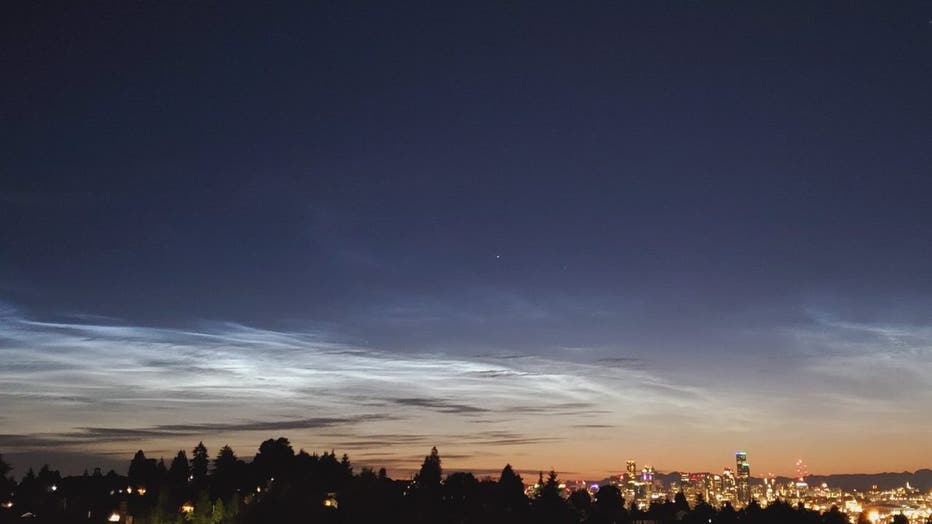Clouds from leftover meteor smoke put on show in pre-dawn hours over Seattle
KENT, Wash. - Those who were up early on Tuesday around the Seattle area were treated to an early celestial show that punctuated summer's arrival a few hours before.
Just before sunrise, a display of cool, blue appeared high above the horizon. But despite the Pacific Northwest's relentless bouts of rain this spring, these clouds were not a sign of wetter hours to come.
Instead, the wispy fragments are "Polar Mesospheric Clouds" — informally known as noctilucent clouds, or "night-shining" clouds. They sit considerably higher in the atmosphere than typical clouds and glow with a beautiful blue hue as the sun sits just below the horizon.
"PMCs are water-ice clouds that form about 50 miles above the surface of the Earth, primarily in the summer hemisphere polar region," says Prof. Cora Randall at the University of Colorado. She is also the principal investigator of the NASA Aeronomy of Ice in the Mesosphere Cloud Imaging and Particle Size instrument.

Noctilucent clouds over Seattle on June 17, 2021. [Photo: Travis Mayfield)
Like regular clouds, they are formed from condensed water vapor, but instead of dust or other Earth-born particles, these clouds coalesce around leftover meteor smoke! The resulting ice particles are just 50 nanometers in size — that is 0.000002 inches across.
But for this to happen, temperatures have to be quite cold — at least -190 degrees F, Randall said. Those temperatures can be found near the poles, some 50 miles high in the mesopause area of our atmosphere.
RELATED: Why clouds could be responsible for the 2021 deadly heat wave in the Pacific Northwest
"Which is why they somewhat ironically form in the summer," she said. "The polar mesopause in summer is the coldest region on Earth, even colder than the winter polar mesopause."
Thus, June and July are the best times to spot PMCs. These clouds form over the North and South Poles but spread to lower latitudes. They can appear at night in summer but are best seen in the 30-60 minutes just before sunrise or after sunset when the sun is just below the horizon.
Many photographers know the drill.

Noctilucent clouds appear over Seattle on June 17, 2021. (Photo: @WestSeattleWx)
"I was up and waiting for them this morning at 3 a.m., when they usually show up this time of year in Washington," said photographer Jeff Knesebeck, who spotted the clouds from Auburn, Washington. "They are beautiful wispy electric blue luminous clouds that are in space, and are easily seen with the unaided eye."
"They are surreal to watch light up pre-dawn sky with anticipation of how large and bright the display will get!" added Noel Bowman, who photographed the clouds from nearby Kent.
RELATED: Seattle weather: Heat advisory this weekend as temperatures soar to near 90 degrees
Part of the beauty of the display is that the clouds seem to give off a glowing blue color, instead of white or gray like traditional clouds.
"It's because of Rayleigh scattering," Randall said. The ice cloud particles are so tiny that they scatter out the shorter light wavelengths like blue light. Light from the sun well below the horizon will shine through the clouds, with the blue light becoming scattered and that's the light you'll see reflected back to your eyes.
They used to be rare sightings and relegated to far northern latitudes. But in recent years, it appears sightings are becoming more frequent and farther south. In recent years, those as far south as Los Angeles and Las Vegas have spotted them.

